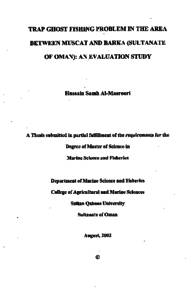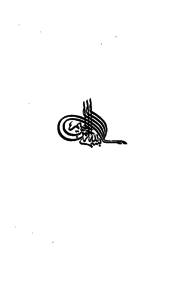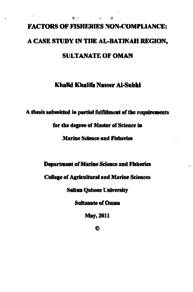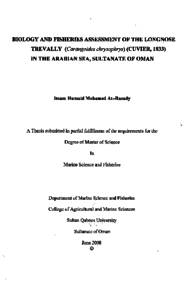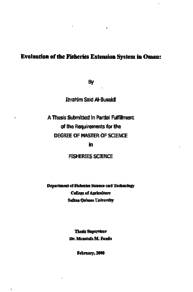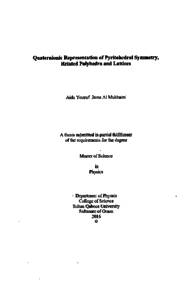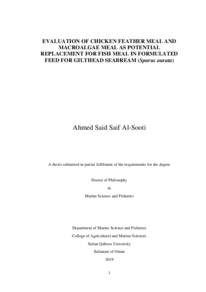Document
Trap ghost fishing problem in the area between Muscat and Barka (Sultanate of Oman) : an evaluation study
Publisher
Sultan Qaboos University
Gregorian
2002
Language
English
English abstract
The main objective of this thesis was to obtain an estimate of the magnitude of ghost fishing by lost fishing traps set in the area between Muscat and Barka in the Sultanate of Oman and to reveal methods that could be employed to mitigate the waste of fisheries resources. The study employed two methods: personal interview (questionnaire survey) and observational method (field trials with baited fish traps). A total of 92 fishermen in 28 villages were interviewed from July to September 2001. The questionnaire survey provided information concerning the rate at which traps were lost by a fisherman, the financial cost of this loss to the fishermen, the perceived reasons for the loss of this gear, and the circumstances leading to non recovery of fish traps. The field experiment was designed to quantify the catch rate of traps that had been lost for various periods of time. Experimental fishing trials were carried out at five traditional fishing grounds (A'Sifah, Yeti, Bunder Jissah, Al-Bustan and Fahal Island) in Muscat and Mutrah towns using 25 traps set at depths between 16 to 36 meter during the period of late November and mid July 2001. The study revealed that a total of 15,390 traps or 18 traps per fisherman are lost every year in the study area. Once lost, these traps were found to remain functional and continue to ghost fish for a period of 3.1 months per year. The three main causes responsible for trap losses were: gear interference, theft and/or vandalism and collisions with boats and ships. Trap fishermen in the study area (70.7 % full time and 29.3 % part time) mainly fish in the vicinity of their village in an average depth of 28.4 meter. Each trap fisherman was found to own and fish around 20.4 traps at a time, and each trap had a useful lifetime of 5.7 months. An average of 12 traps are hauled per fishing trip resulting in each trap being hauled after an average soak time of 2.8 days. The average catch of a trap costing 12 O.R. was found to be 12.5 kg per week resulting in an income of 10.315 0.R/trap/week. On average ghost fishing i ortality was estimated at 1.34 kg/trap/day, and was found to decrease with time, A model was developed to estimate trap ghost fishing mortality, which predicted a total trap ghost fishing mortality of 1,102.4 metric tons per year. The total average equivalent annual tangible economic loses resulting from ghost fishing by traps in the study area was estimated at 1,011,594 O.R., which amounts to 1.92 % of the total landing value of the entire Sultanate in the year 2000. To reduce this misuse of fisheries resources, it is recommended that future traps be better marked, that they be equipped with timed-release or degradable sections or panels, and that openings be included in the traps for the release of sub legal size Conflicts with other fishing vessels and other types of gear could be reduced by implementing a zonation policy for the different types of gear
Description
Thesis
Member of
Resource URL
Arabic abstract
هدفت الدراسة بشكل رئيس على تقييم ظاهرة الصيد الخفي الناتجة عن فقدان أقفاص الصيد (الدوابي) في المنطقة بين مسقط وبركاء في سلطنة عمان وعلى إبراز الطرق التي يمكن أن تحد من هذه الظاهرة. استخدمت في هذه الدراسة طريقتين هما الاستبيان والتجربة الميدانية، شمل الاستبيان ۹۲ صيادا حرفيا ممن يزاولون مهنة الصيد بالدوابي من ۲۸ قرية في الفترة من يوليو إلى سبتمبر ۲۰۰۱، وقد أبرز معلومات تعلقت بمعدل فقدان الأقفاص والأسباب التي أدت إلى ذلك ومقدار الخسارة للصيادين والتأثيرات المترتبة من جراء فقدان هذه الأقفاص صممت التجربة الميدانية والتي أنجزت في الفترة من نوفمبر إلى يوليو ۲۰۰۱ في خمس مواقع صيد (السيفة ويتي وبندر الجصة و البستان وجزيرة الفحل) في ولايتي مسقط ومطرح لكي تقيم معدل الصيد المهدر والوفيات الأقفاص الصيد المفقودة خلال مدة صلاحيتها، وقد استخدم في هذه التجربة ۲۰ قفصا وزعت على مختلف المواقع في اعماق تراوحت بين ۱۹ و ۳۹ مترا. . أظهرت الدراسة أن مجموع ۱۰۳۹۰ قفصا أو بمعدل ۱۸ قفصا لكل صياد تفقد سنويا في منطقة البحث حيث تستمر هذه الأقفاص بالصيد لمدة ۳٫۱ شهرا بعد فقدانها. ووجد أن الأسباب الرئيسة الثلاثة المسئولة عن الفقدان هي: تداخل أدوات الصيد والسرقة و/أو التخريب و التصادم بالقوارب والسفن. يستخدم كل صياد حرفي من صيادي المنطقة (۷۰ , ۷ % متفرغين كليا و۲۹٫۳% متفرغين جزئيا) ما مجموعه ۲۰٫4 قفص للصيد في مياه معدل عمقها ۲۸٫4 مترا في المناطق المجاورة لقراهم, حيث يبلغ معدل فترة الاستخدام أو الصلاحية لهذه الأقفاص ۷, 5 شهرا, ويقوم كل صياد بفحص ۱۲ قفصا في كل رحلة بعد أن يكون كل قفص قضى فترة في الماء مقدارها ۲٫۸ يوما. وأوضحت الدراسة أن كل قفص ينتج ما مقداره ۱۲٫5 كجم في الأسبوع الواحد بمعدل دخل وقدره ۱۰٫۳۱۰ ريالا عماني في الأسبوع, ويقدر سعر القفص الواحد بمعدل ۱۲ ريالا عماني. قدرت الوفيات من الصيد الناتج عن فقدان الأقفاص واستمرارها في الصيد بمعدل 1 , 34 كجم/قفص ليوم والذي وجد أنه يتناقص تدريجيا مع الوقت, الأمر الذي تطلب تطوير معادلة تتنبأ بمعدل الصيد المهدر لكل ققص خلال مدة معينة, ودلت هذه المعادلة على مقدار وفيات سنوي وقدره ۱۱۰۲٫4 طنا متري ناتج من فقدان الأقفاص في منطقة الدراسة, وكان مقدار التكلفة السنوية الملموسة لهذه الخسارة ۱۰۱۱۰۹4 ريالا عماني, أي ما يعادل ۱٫۹۲% من إجمالي قيمة إنتاج السلطنة لعام ۲۰۰۰م. التخفيض هذا الهدر في المصادر السمكية أوصت الدراسة بإيجاد طرق بديلة ومناسبة لتحديد مواقع الأقفاص وباضافة فتحات خروج موقتة ومزودة بمواد ذائبة وفتحات الخروج الأسماك الصغيرة. ويمكن تقليل المشاكل الناتجة من تداخل أدوات الصيد وتصادمها مع محركات القوارب بتقنين مناطق الصيد كوسيلة إدارة المواقع الصيد لمختلف الأدوات.
Category
Theses and Dissertations

